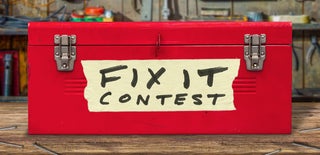Introduction: Hand Plane Restorations
Vintage Stanley planes are great restoration projects. They can be found in all manners of deterioration, and often come at a very reasonable price.
Step 1: Vintage Planes
The following website will help identify what year plane you are dealing with by some of its features. http://www.timetestedtools.net/2016/01/27/stanley-bench-plane-typing/
Step 2: Disassemble
Disassemble the planes and keep track of all the parts. Photos are a good way to document the assembly process.
Step 3: Remove Paint
Two of the planes I purchased were spray painted all over, with a good helping of rust underneath. I used aircraft remover to remove the paint and japanning.
Step 4: Vinegar and Salt
I used a vinegar salt solution for rust removal. The process acts much faster than vinegar alone. You have to be careful how long you soak the parts for and the strength of the metal because this can cause deterioration to the metal.
Step 5: Baking Soda
Soak the parts in baking soda while you clean them with a wire brush. This will neutralized the acid from the previous solution.
Step 6: Dry
Dry the parts so they don't flash rust. You can do this in the oven or hot sun.
Step 7: Polish
Use a buffing wheel with compound to buff any parts that can use a shine.
Step 8: Tape
Tape off any parts that you do not want painted.
Step 9: Prime
Prime the parts to give a solid base for paint.
Step 10: Paint
Paint the frogs and bodies.
Step 11: Assembly
Attach the frog to the base.
Step 12: Irons
Shape and hone the Irons. I used a grinding stone, water stone and leather with green compound. I will not go into the intricacies of blade geometry here, but the primary bevel, micro-bevel, relief bevel and back bevel are all important aspects of the cutting edge.
Step 13: Chip Breakers
Reassemble the iron and chip breaker. The distance the chip breaker sits from the edge of the iron is important. The following article is worth a look if you are interested in chip breakers.
http://www.popularwoodworking.com/woodworking-blogs/chris-schwarz-blog/reconsidering-chipbreakers-as-not-totally-evil
Step 14: Front Knob
Turn some front knobs on the lathe to fit the different bases. Then apply your desired finish.
Step 15: Tote
Fashion a tote from a block of wood. Drilling the center hole can be a bit tricky. Make sure you test the alignment before you complete the piece.
Step 16: Rough Sand
Use a belt sander to roughly shape each tote.
Step 17: Finish Sanding
Use finer sanding instruments and hand sanding to complete the totes.
Step 18: Finish
Apply a coat of Danish oil and when dry buff on some wax.
Step 19: Adjust
Complete reassembly and make adjustments.

First Prize in the
Fix It Contest











